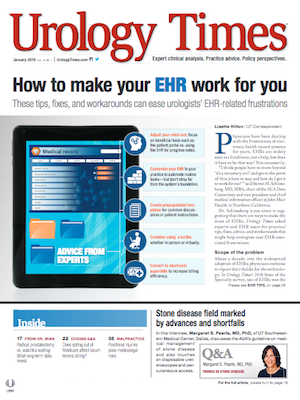Publication
Article
Urology Times Journal
Tolterodine pretreatment does not improve stent symptoms
Author(s):
Pretreatment for 14 days with tolterodine (Detrol) and Tamsulosin (Flomax) did not appear to relieve ureteral stent symptoms better than tamsulosin alone as measured by the validated Ureteral Stent Symptom Questionnaire, say the authors of a recent study.
Pretreatment for 14 days with tolterodine (Detrol) and Tamsulosin (Flomax) did not appear to relieve ureteral stent symptoms better than tamsulosin alone as measured by the validatedUreteral Stent Symptom Questionnaire (USSQ), say the authors of a recent study.
Stent symptoms are a significant problem to patients undergoing endoscopic stone surgery. Yet, the optimal medical therapy to address this issue has yet to be defined, according to the authors.
The researchers were disappointed with their findings and report that this further validates the principle that this class of medications has a limited clinical impact on patients with ureteral stent symptoms. The team of investigators concluded that other alternatives should be pursued.
“We are potentially exposing patients to some degree of side effects and costs,” said study investigator John Roger Bell, MD, assistant professor of urology at the University of Kentucky, Lexington.
Also see - Stone surgery: Should outcome target change?
The authors previously looked at the use of tolterodine to relieve ureteral stent symptoms in a randomized control trial, but the findings were disappointing and showed no significant benefit (J Urol 2016; 195:385-90). For this current investigation, which was presented at the 2018 AUA annual meeting in San Francisco, the authors theorized that pretreatment with tolterodine could improve outcomes by allowing tolterodine to attain a steady state concentration prior to the insertion of the ureteral stent.
They conducted a double blind, placebo-controlled trial in which patients were randomized to undergoing ureteroscopy and receive tamsulosin plus tolterodine (combination therapy) or to tamsulosin plus placebo (monotherapy). The medical therapies were given 14 days prior to stent insertion and continued for 7 days post operatively.
The study included patients undergoing uncomplicated ureteroscopy for urinary stone disease, and individuals were excluded if they were unable to take anticholinergics. In addition, patients were excluded if they already were taking anticholinergic medications for lower urinary tract symptoms.
The primary outcome for the study was the USSQ score. The USSQ was assessed at time of enrollment, day of surgery, day after surgery, last day of medication or day of stent removal, and day after stent removal. The authors added domain scores for each patient and compared the two groups.
“Until we come up with a more targeted or better therapy, this is what people are using,” said Dr. Bell. “Yet, it may be providing little benefit.”
The authors were hoping to enroll 100 patients and have data on at least 75. However, to date only 74 patients were enrolled and 43 were included in the final analysis. Dr. Bell said he does not expect that the trends would have changed significantly if there were a larger cohort.
Next:No difference between groupsNo difference between groups
“When evaluating these patients’ symptoms based on the USSQ questionnaire, we found no difference between the groups,” Dr. Bell said in an interview with Urology Times. “Currently, we have the trial on hold.”
He said unfortunately at this time, there are no proven effective medical therapies to provide patients who are undergoing endoscopic stone surgery. Dr. Bell said it is just matter of tailoring treatment to each patient based on their individual symptoms.
Read: 8% of stone surgery patients use opioids long term
“We need to keep evaluating why patients have stent symptoms. We don’t really have a good answer for that yet,” said Dr. Bell.
Dr. Bell is a consultant for Boston Scientific and a speaker for Cook Medical.





















